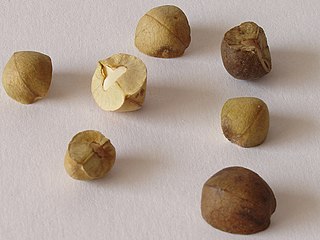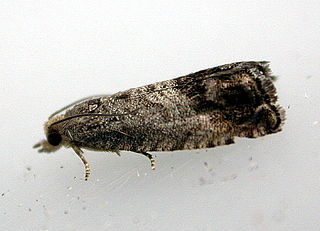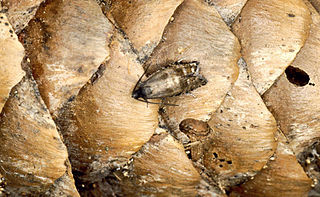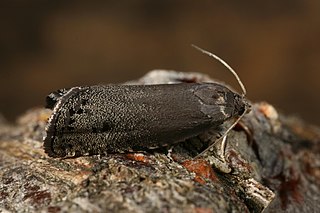
The Tortricidae are a family of moths, commonly known as tortrix moths or leafroller moths, in the order Lepidoptera. This large family has over 11,000 species described, and is the sole member of the superfamily Tortricoidea, although the genus Heliocosma is sometimes placed within this superfamily. Many of these are economically important pests. Olethreutidae is a junior synonym. The typical resting posture is with the wings folded back, producing a rather rounded profile.

Mexican jumping beans are seed pods that have been inhabited by the larva of a small moth and are native to Mexico. The pod is usually tan to brown. They are from the shrub Sebastiania pavoniana, often also referred to as "jumping bean". However, they are not related to actual beans, but rather to spurges. The beans are considered non-toxic but are not generally eaten. In the spring, when the shrub is flowering, moths lay their eggs on the shrub's hanging seedpods. When the eggs hatch, tiny larvae bore into the immature green pods and begin to devour the seeds. The pods ripen, fall to the ground and separate into three smaller segments, and those segments are called Mexican jumping beans. As the tiny larvae inside curl up and uncurl, they hit the capsule's wall with their heads – and the bean jumps. They move more as temperatures rise, the larva eats away the inside of the bean and attaches itself to the inside of the bean with silk-like thread.

The codling moth is a member of the Lepidopteran family Tortricidae. They are major pests to agricultural crops, mainly fruits such as apples and pears, and a codling moth larva is often called an "apple worm". Because the larvae are not able to feed on leaves, they are highly dependent on fruits as a food source and thus have a significant impact on crops. The caterpillars bore into fruit and stop it from growing, which leads to premature ripening. Various means of control, including chemical, biological, and preventive, have been implemented. This moth has a widespread distribution, being found on six continents. Adaptive behavior such as diapause and multiple generations per breeding season have allowed this moth to persist even during years of bad climatic conditions.

Cydia is a large genus of tortrix moths, belonging to the tribe Grapholitini of subfamily Olethreutinae. Its distinctness from and delimitation versus the tribe's type genus Grapholita requires further study.

Sophora chrysophylla, known as māmane in Hawaiian, is a species of flowering plant in the pea and bean family, Fabaceae, that is endemic to Hawaii. It is highly polymorphic, growing as a shrub or tree, and able to reach a height of 15 m (49 ft) in tree form. Yellow flowers are produced in winter and spring.
Cydia pomonella granulovirus (CpGV) is a granulovirus belonging to the family Baculoviridae. It has a double-stranded DNA genome that is approximately 123,500 base pairs in length with 143 ORFs. The virus forms small bodies called granules containing a single virion. CpGV is a virus of invertebrates – specifically Cydia pomonella, commonly known as the Codling moth. CpGV is highly pathogenic, it is known as a fast GV – that is, one that will kill its host in the same instar as infection; thus, it is frequently used as a biological pesticide.

Cydia succedana, or Gorse Pod Moth is a species of moth of the family Tortricidae. It is found in Europe and has been introduced to New Zealand.

Cydia splendana, the chestnut tortrix, is a moth of the family Tortricidae. It is found in Europe. It is also known as the acorn moth, but this can also refer to Blastobasis glandulella from North America, which belongs to the more primitive family Blastobasidae.

Cydia is a graphical user interface of APT for iOS. It enables a user to find and install software not authorized by Apple on jailbroken iPhones, iPads and iPod Touch devices. It also refers to the digital distribution platform for software on iOS accessed through Cydia software. Most of the software packages available through Cydia are free of charge, although some require purchasing.

Cydia fagiglandana, the beech moth, is a moth of the family Tortricidae.

Cydia strobilella, the spruce seed moth, is a moth of the family Tortricidae. It is found in Europe.

Cydia ingens, commonly known as the longleaf pine seedworm moth, is a species of moth in the family Tortricidae. It is found in southeastern North America. The caterpillars feed on the seeds of longleaf pine, slash pine, and loblolly pine. It was first described by American entomologist Carl Heinrich in 1926 as Laspeyresia ingens.

Cydia pactolana, the spruce bark tortrix, is a moth of the family Tortricidae. It is found in central, northern and eastern Europe as well as Siberia. In Japan, the subspecies Cydia pactolana yasudai is present.

Cydia amplana, the rusty oak moth, is a moth of the family Tortricidae. It is found from northern, central and southern Europe to Asia Minor, south-western Russia and Transcaucasus.

Cydia cosmophorana is a moth of the family Tortricidae. It is found from northern and central Europe to eastern Russia.

Cydia illutana is a small moth of the family Tortricidae. It is found from western and central Europe, north to Scandinavia and east to Russia (Siberia).

Cydia millenniana, the larch gall moth, is a moth of the family Tortricidae which galls larch. It is found from Europe to Russia and the Korean Peninsula.
Cydia zebeana, the larch bark moth, is a moth of the family Tortricidae. It is found in central and eastern Europe, Siberia and China. It is also known from the Netherlands.
Cydia crassicornis is a moth of the family Tortricidae. It was first described by Lord Walsingham in 1907. It is endemic to the island of Hawaii.

Cydia coniferana is a Palearctic moth belonging to the family Tortricidae. The species was first described by Saxesen in 1840. The wingspan is 11–13 mm. The forewings are dark fuscous, the costa posteriorly with white strigulae, some ending in obscure leaden-metallic marks. There is an irregular erect white dorsal median spot, including a dark fuscous strigula. The ocellus is edged with leaden-metallic, and crossed by several black dashes. The hindwings are fuscous. The larva is dull yellowish ; head pale brown

















